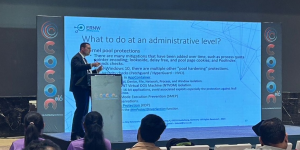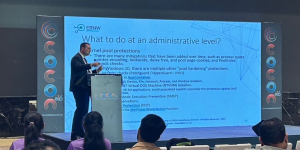Two weeks ago, I was at the c0c0n conference in Cochin (India). This conference is quite special for at least two considerations. At first, this is – to the best of my knowledge – one of the few conferences which officially brings together hackers, industrials, politics, and security forces. This is not always obvious for all these different persons to talk together, may be due to a lack of mutual understanding 😉. But for a couple of days, all of them meet, talk, exchange, and they share mutual needs and appropriate solutions. And this may explain the second consideration, why c0c0n is one of the oldest cyber security conferences in India (more than 15 years). And yes, this is the conference where police forces directly pick you up from the gates of your plane at airport, sitting you at the back of a police car to drive you to your hotel with emergency lights 😊
During this event, we provided a workshop and a talk (slides are coming), both talking about the security of device drivers in Windows. For short, a device driver is a piece of software that is used to manage a given device (whatever the notion of device covers, from removable ones such as USB sticks to those definitively set to your motherboard). In an organization, it is perfectly possible to control the list of software and potentially the list of devices allowed on machines. But there is sometimes a blind spot to know exactly which device drivers are really used (from those setups by the OEM to the ones installed automatically when a device is plug in the system). In addition, the security issues associated with this kind of drivers is sometimes a real concern. Why? Because some device vendors do not provide enough security (not to say basic quality) in their software. A lot of the vulnerabilities exploited in drivers are always the same: exploiting a feature that “should not be here” and whose access is not “enough secure”, at least far from our today’s standards, to say the few. In fact, a lot of device drivers are unfortunately written reusing part of some public but highly deprecated projects, including codes coming from the Windows Driver Kit (WDK) initially distributed with Windows NT 4.0, back in the good old days where Windows 98 was the norm and the security was the exception 😉. In some cases, it is not hard to find samples reusing code coming from 1993 in modern drivers.
The point is not to blame the past. Some pieces of code are still relevant to be used, even nowadays. But some software architectures and system security of that legacy time are nowadays totally deprecated. And some drivers keep using dangerous features from that time, when they do not directly provide security bypasses, for dubious reasons. The reasons have as much to do with the fact that some drivers have never been updated (“why changing something since it works?”) in the past as with the fact that some drivers may simply never be updated (by design issue, no update capabilities, signed drivers still exploitable, software provider bankrupted, …). The fact is that driver vulnerabilities are not close to disappear.
Answering the problem is half technical and half organizational. On the first hand, on the technical side, there is the ability to analyze the vulnerabilities in drivers, mostly with reverse engineering, understanding the potential consequences and deploying some technical mitigations. On the other hand, there is a real topic about how to deal with existing drivers, potentially vulnerable. From the strict management of device and security policies improvement for clients to the enhancement of drivers’ code quality for software providers, there are plenty of aspects to consider. And that was exactly the point we highlighted during this conference, first in details during the workshop with more than twenty participants [😊] and then during the talk. By the way, we will give a similar online workshop (but focus on malware) in the end of November, where “seats” are still available 😊.
Last but not least, the c0c0n conference is also the place where there is a track regarding Counter Child Sexual Exploitation, talking about this highly humanitarian topic. I met very experienced police officers from different nationalities and other people involving in protecting children from abuse. These persons do such a hard job to make the world a safer place for our children. I also wanted to stress the importance of this conference, which also helps to protect children.
All the best,
Baptiste.

